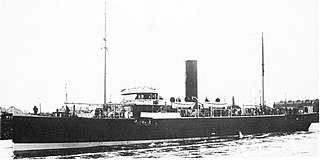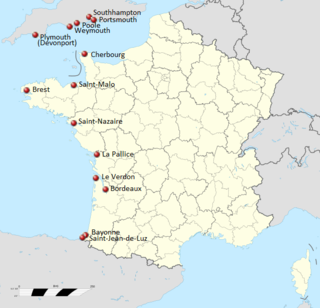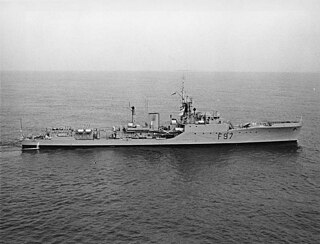
Q-ships, also known as Q-boats, decoy vessels, special service ships, or mystery ships, were heavily armed merchant ships with concealed weaponry, designed to lure submarines into making surface attacks. This gave Q-ships the chance to open fire and sink them.

Operation Aerial was the evacuation of Allied military forces and civilians from ports in western France. The operation took place from 15 to 25 June 1940 during the Second World War. The embarkation followed the Allied military collapse in the Battle of France against Nazi Germany. Operation Dynamo, the evacuation from Dunkirk and Operation Cycle from Le Havre, had finished on 13 June. British and Allied ships were covered from French bases by five Royal Air Force (RAF) fighter squadrons and assisted by aircraft based in England to lift British, Polish and Czech troops, civilians and equipment from Atlantic ports, particularly from St Nazaire and Nantes.

RMS Lancastria was a British ocean liner requisitioned by the Government of the United Kingdom during the Second World War. She was sunk on 17 June 1940 during Operation Aerial. Having received an emergency order to evacuate British nationals and troops from France, the ship was loaded well in excess of its capacity of 1,300 passengers. Modern estimates suggest that between 4,000 and 7,000 people died during the sinking — the largest single-ship loss of life in British maritime history.
HMT Warwick Deeping (H136) was a naval trawler of the British Royal Naval Patrol Service during World War II, sunk off the Isle of Wight in October 1940.

HMS Russell was one of a dozen Blackwood-class frigates of second-rate anti-submarine frigates built for the British Royal Navy during the 1950s. She was named for Edward Russell, 1st Earl of Orford, commander at the Battle of Barfleur in 1692.

HMS Thorough was a British submarine of the third group of the T class. She was built as P324 by Vickers Armstrong, Barrow, and launched on 30 October 1943. So far she has been the only ship of the Royal Navy to bear the name Thorough.
Frances Haffey Brooke-Smith, GC was Royal Navy Reserve bomb disposal officer awarded the George Cross for "great gallantry and undaunted devotion to duty" while defusing German bombs during the Blitz in 1940.
Vorpostenboot, also referred to as VP-Boats, flakships or outpost boats, were German patrol boats which served during both World Wars. They were used around coastal areas and in coastal operations, and were tasked with – among other things – coastal patrol, ship escort, and naval combat.

Naval trawlers are vessels built along the lines of a fishing trawler but fitted out for naval purposes; they were widely used during the First and Second World Wars. Some, known in the Royal Navy as "Admiralty trawlers", were purpose-built to naval specifications; others were adapted from civilian use. Fishing trawlers were particularly suited for many naval requirements because they were robust vessels designed to work heavy trawls in all types of weather, and had large clear working decks. A minesweeper could be created by replacing the trawl with a mine sweep. Adding depth charge racks on the deck, ASDIC sonar below, and a 3-inch (76 mm) or 4-inch (102 mm) gun in the bow equipped the trawler for anti-submarine duties.
Naval trawlers were purpose-built or requisitioned and operated by the Royal Navy (RN), mainly during World Wars I and II. Vessels built to Admiralty specifications for RN use were known as Admiralty trawlers. All trawlers operated by the RN, regardless of origin, were typically given the prefix HMT, for "His Majesty's Trawler".

An armed yacht was a yacht that was armed with weapons and was typically in the service of a navy. The word "yacht" was originally applied to small, fast and agile naval vessels suited to piracy and to employment by navies and coast guards against smugglers and pirates. Vessels of this type were adapted to racing by wealthy owners. The origin of civilian yachts as naval vessels, with their speed and maneuverability, made them useful for adaptation to their original function as patrol vessels. In the United States Navy armed yachts were typically private yachts expropriated for government use in times of war. Armed yachts served as patrol vessels during the Spanish–American War and the World Wars. In the latter conflicts, armed yachts were used as patrol vessels, convoy escorts, and in anti-submarine duties. In the United States, yachts were purchased from their owners with the owners given an option to repurchase their yacht at the close of hostilities.

A naval drifter is a boat built along the lines of a commercial fishing drifter but fitted out for naval purposes. The use of naval drifters is paralleled by the use of naval trawlers.

HMS Baralong was a cargo steamship that was built in England in 1901, served in the Royal Navy as a Q-ship in the First World War, was sold into Japanese civilian service in 1922 and scrapped in 1933. She was renamed HMS Wyandra in 1915, Manica in 1916, Kyokuto Maru in 1922 and Shinsei Maru No. 1 in 1925.

RMS Franconia was an ocean liner operated by the Cunard Line from 1922 to 1956. The liner was second of three liners named Franconia which served the Cunard Line, the others being Franconia (1910) built in 1910 and the third Franconia in 1963.

For other ships called SS Oronsay, see List of ships named Oronsay

HM Trawler Alvis was a British trawler that was taken up from trade and used by the Royal Navy during the Second World War. She was returned to the fishing industry at the end of hostilities in 1945.

HMS Albrighton was a Type III Hunt-class destroyer built for the British Royal Navy. She entered service in February 1942, first carrying out an attack on German ships in the English Channel then taking part in the Dieppe Raid, rescuing survivors from the sinking destroyer HMS Broke. Albrighton was next assigned to search for and destroy the German auxiliary cruiser Komet, then escorted a convoy to Gibraltar in prevision of the Allied landings in North Africa. Between December 1942 and April 1943, she participated in the sinking of three more Axis ships with the First Destroyer Flotilla. During the Normandy Landings in June 1944, Albrighton served as a headquarters ship, then sank two German trawlers in the weeks after the invasion. After being converted to a destroyer in early 1945, she was damaged in a collision with a Landing Ship, then was assigned to the British Eastern Fleet. However, the war ended before she was deployed and Albrighton went into reserve.
HMT Lincoln City was an anti-submarine warfare (ASW) trawler in the service of the British Royal Navy during World War II. She was bombed during an air raid and sank on 21 February 1941 at the Faroe Islands.
The Arctic Viking(H452) was a British trawler ship that sailed from the Port of Hull in the East Riding of Yorkshire, England. Whilst the vessel was originally a commercial fishery ship, she also served as an anti-submarine vessel during the Second World War where she was sunk by enemy action. She was later involved in the Cod Wars, being actually targeted by a vessel from the Icelandic Navy. Besides her wartime service, she had two other accidents; one a collision in 1956 and another where she sank with the loss of five of her crew, 16 miles (26 km) off Flamborough Head in October 1961.

HMS Poppy was a Flower-class corvette that served in the Royal Navy as a convoy escort during World War II.













